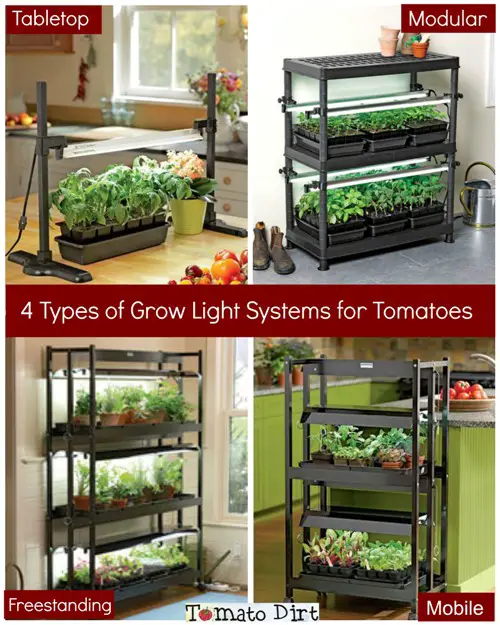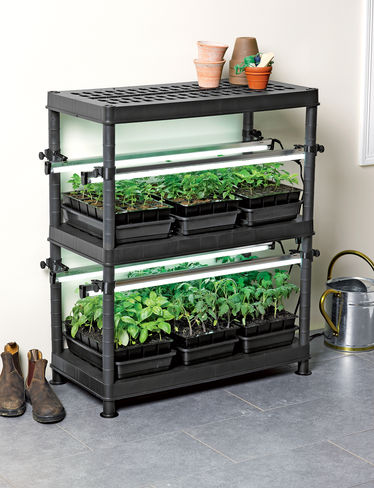FREE: 10 Must-Know Tomato Growing Tips Get The Guide
Read our affiliate disclosure here.
Choosing a Grow Light System for Growing Tomatoes from Seed
Since 2010, Tomato Dirt has garnered 4.8+ million views, making it the web’s leading online source for growing tomatoes in the home garden. Award-winning writer and Tomato Dirt owner Kathy Widenhouse has helped thousands of home gardeners grow healthier tomatoes. Be one of them when you get Tomato Dirt’s Growing Guide here.
The process of choosing a grow light system for your tomato seedlings may seem a bit overwhelming. There are so many options.
Here’s the dirt about grow lights systems.
Do You Need One?
Tomato seedlings require bright light in order to be healthy and grow strong. Once they bust through the potting mix surface, they have already used considerable energy reserves.
Direct, intense light allows the seedling to manufacture food and withstand diseases without incurring extra stress. Consider the windows in your home to determine if there is one that has what it takes to grow healthy tomato seedlings.
Window Positions. Do you have a south-facing window (which provides the strongest natural light)? Follow the lighting patterns to determine if the potential growing area receives 12-16 hours of light a day.
Extra Space. Plants will grow towards the light, so you need to be able to rotate them when they start to bend. Is there flexibility in the area so you can rotate seed trays?
Seal. If your window area is drafty, it may not be a good choice. Tomatoes grow best in a consistent room temperature (between 65º-85ºF).
If you grow your tomato seedlings at a window that doesn’t provide consistent, strong natural light, you run the risk of growing leggy, weak plants or worse, losing them to disease.
In some cases, your sunniest windowsill will provide the intensity of light and conditions that your tomato seedlings need. But if not, then the best solution is choosing a grow light system to start your tomato seedlings.
Choosing a Grow Light System
Tomato grow lights systems have 2 components: the grow light, comprised of the lamp (bulb), electrical ballast (which holds the bulb), and often a reflector (a shield that maximizes the light and controls its heat) – and the structure.
(Read the advantages of each of the four kinds of tomato grow lights and how to choose the best one for your situation.)
4 Types of Grow Light Structures
A grow light structure is a stand from which lights are suspended and under which plants are set. Its shelves hold seedling trays. Arms or sides support the light ballast.
Decide how much room you want to dedicate to your tomato
grow lights system. Assess and measure your dedicated growing area. Be sure your growing area is draft-free and near an electrical
outlet. Armed with that information, you can set about choosing a grow light system that will work best for your
situation.
1. Tabletop Structures
Beginning gardeners or gardeners with limited space may choose table top growing stands that accommodate single or double trays (seed starting trays for the home gardener have between 18 and 48 cells, depending upon which tray you choose.) You can even start out with a single starter light stand.
2. Freestanding Structures
Freestanding grow lights units are available in all sizes, from compact units to multiple shelving units. Some freestanding structures are on wheels so you can move them easily. Those who want to start more seedlings – or who have more space dedicated to growing tomato seedlings indoors – may choose larger four-, eight-, twelve-, or even sixteen-tray freestanding stands.
3. Modular Units
A modular unit allows you to start with just one shelf and
light to use now and then add units vertically to multiply your growing space.
This is a practical way to get started with growing your own tomatoes from
seeds. In most cases, a modular unit is easy to take apart and store compactly
during the off-season.
The Stack-n-Grow System is one of our favorite modular growing units.
4. Shelving
One popular way to make an inexpensive light shelf is to use a simple shelving unit from a discount home improvement store or online. You can hang fluorescent shop lights from shelf undersides of the shelves with wire, chain, or rope. You can even use a simple bookshelf as a grow light stand. You can purchase basic grow lights or save even more money when you simply use large fluorescent shop lights rigged up over simple shelves.
Grow Lights Ballast Needs to Be Adjustable
In the process of choosing a grow light system, consider flexibility. Regardless of which type of grow light structure you choose, make sure you have a set up that allows you to adjust the height of the electrical ballast. The grow lights ballast is a metal mechanism that holds the grow lights bulbs and connects the lamp with an electrical cord to the electrical outlet nearby.
You want to position the lights 3-4 inches from the soil surface during germination and during the seedlings’ first days. As the plants grow taller, you need to raise the ballast a bit higher to give them room to grow up.
Many grow lights ballast systems are rigged with S-hooks or chains. You can also get adjustable grow lights hangers to use with all kinds of different lights systems. The image on the right shows one of our favorite adjustable grow lights hangers (available from Gardener's Supply.) As the plants grow, the light height can adjusted so lamps remain 3-4 inches above the plants.
More about tomato grow lights
Tomato grow lights explained ...
Should I Use LED Grow Lights for Tomatoes? FAQs ...
Tomato grow lights for seedlings: frequently asked questions ...
Using fluorescent grow lights to start seeds, grow tomatoes ...
Fluorescent grow light systems to choose from ...
Return from Choosing a Grow Light System to Tomato Dirt home
As an Amazon Associate and Rakuten Advertising affiliate I earn from qualifying purchases.
SHARE THIS PAGE:
FREE! 10 Must-Know Tomato Growing Tips: 20-page guide
Get yours here:







New! Comments
Have your say about what you just read! Leave a comment in the box below.